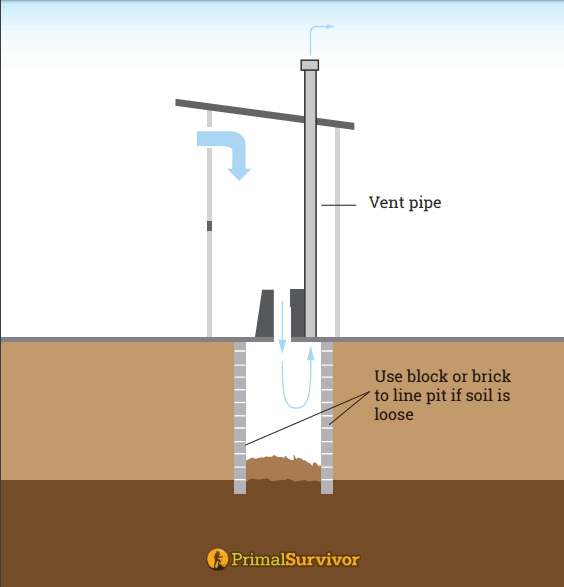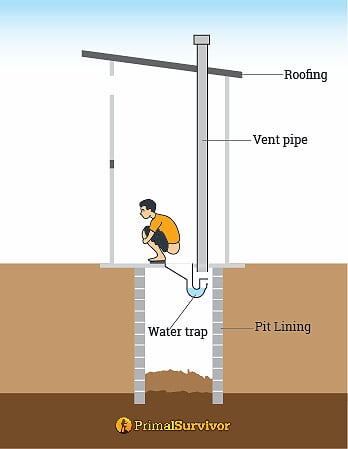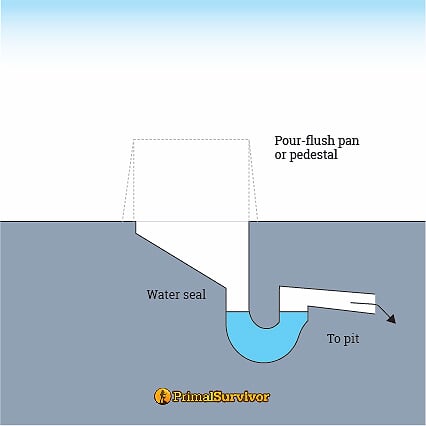When you think of a latrine, you probably think of a big hole in the ground with a seat and outhouse over it. These old-fashioned latrines are still great options for off-grid cabins or emergency preparedness.
However, latrine design has improved drastically over the years. There are newer ways to make latrines, so they are safer, cleaner, and smell less.
This guide will give instructions for a basic latrine and then explain other options, especially for multiple families or groups.
I’m Not Off-Grid. Why Would I Need a Latrine?
You’ll need some sort of latrine if you are planning to live off-grid. But knowing how to make a latrine is something everyone should know how to do.
Here’s why:
In virtually every major disaster that’s occurred, the plumbing goes down. Bucket toilets will work for a few days. After this, you’ll end up with a bucket filled with human waste (read how the twin-bucket toilet system works here).
Where do you empty the bucket of crap? There won’t be any trash collection after a disaster – and it’s illegal to put human waste in the trash anyway.
You could wait until the plumbing resumes, but that could be months. Imagine having buckets of human waste festering in your home for months!
Digging a latrine is the safest and easiest solution for getting rid of human waste.

Before You Build
- Learn where any underground utilities are located, such as cable wires. You don’t want to hit these while digging your latrine.
- Talk to your neighbors about sharing a latrine pit. Agree on where the pit will be located.
- Gather some tools; a full-sized spade will be the best tool for the job, but in a pinch, your survival shovel will work. We like the Gerber E-tool, which is portable and extremely tough.
1. Basic Latrine Instructions

This is the simplest way to make a latrine. If you use it to dump waste from buckets, you can dig a shallower latrine. If you are going to go to the bathroom in the latrine or are dumping waste from multiple families, then you’ll need it to be deeper.
Instructions:
- The latrine should be at least 10 feet from your home and 100 feet from wells or creeks. Ideally, the latrine should be off your property line.
- Ideally, your latrine is about 4 feet deep. Two feet deep is sufficient, though. The hole should be about 1 foot wide.
- If you see water while digging, stop. It means you’ve reached the water table.
- After going #2, cover the waste with a bit of dirt or mulch.
- When not in use, place a heavy-duty piece of cardboard or wood board over the hole. This will keep pests out.
- When the latrine is full to the 1-foot line, it is full and should be covered.
- Mark the location of the full latrine.
- Never dispose of plastic bags in the latrine. Only special compostable bags designated for latrines can go in.
- Dig a new latrine as necessary.
You can also dig a larger latrine and create a shelter for it. It will take longer for the latrine to fill up, making it more practical for regular use or large families.
Potential Issues:
While this is the simplest, cheapest latrine to make, it isn’t always the best solution. Pit latrines can quickly start to smell bad. They can get infested by flies and mosquitoes.
Pit latrines can also cause groundwater contamination in situations where the water table is high. So, they are not a good solution after flooding.
If the soil is very loose, the pit must be lined to prevent the latrine from caving in. This can be done with wood planks, bricks, or concrete. However, it will take more time to construct.
2. Raised-Pit Latrines

If the groundwater level is high or the area is prone to flooding, a simple latrine will not work. One option is to make a raised-pit latrine.
Unfortunately, there is no discreet or short-term way of making these latrines. A large mound or structure will have to be created to contain the waste.
Guidelines:
- The latrine can be raised using a mound of earth, concrete, or bricks.
- The top slab of the latrine must be at least ½ a meter above the highest water level.
3. Vented Improved Pit (VIP) Latrines

If you are thinking of making a latrine for a cabin, then you’ll probably want to use this design. The basic concept is similar to a basic dug latrine or raise-pit latrine. It can be lined or unlined. The main difference is that a vent pipe goes from the pit and out of the structure.
This vent allows for continuous airflow in the latrine, so foul odors and gases don’t build up. The vent also reduces the flies: The latrine structure’s interior is kept dark, so any flies in the pit go up towards the vent.
A screen over the vent prevents the flies from exiting, so they eventually die and fall back into the pit.
4. Pour-Flush Latrines

With these latrines, waste goes through a curved pipe. After using the latrine, water is poured down the pipe. The water forces waste into the latrine pit. Some water remains in the pipe, making a seal preventing odors from entering the latrine structure.
Aside from keeping out odors and flies, this type of latrine has other benefits. The pipe can be positioned, so waste goes to a pit directly underneath. Or the pit can be placed away from the structure. This makes it possible to put a latrine inside a house but still have the waste pit outdoors. The pipe can be moved when one pit is full, so waste is redirected into another pit.
The first downside is that you will need water for flushing. About 1-3 liters of water is required to force waste down the pipe and to create a seal.
The other downside is that you should not use toilet paper (or corn husks, magazine pages, etc.) with this type of latrine. The paper will get stuck in the pipe. Thus, it is only popular in places where anal cleansing is done with water (more about this in the Alternatives to Toilet Paper section).


Planning Ahead for Emergencies
Even if you think you will never need to make a latrine, I’d still urge you to think about how you’d go to the bathroom in the aftermath of a disaster. A latrine might not be the best option (especially if you live in an apartment).
Suggested reading:
- Twin-bucket toilet instructions
- Best composting toilets
- How to wash your hands without water
- Toilet paper alternatives
What’s your emergency toilet plan? Let us know in the comments!



Here is a thought…
I have a Septic Tank with a 18 inch square access port. Normally its about 24 inches under surrounding surface.
I plan to build a latrine over the top of the tank with a shoot that goes from seat to tank. I’ll incorporate a stack to ventilate the shack into the design. Also a flush to maintain cleanliness of seat(s) and interior as required using rain collected from roofs.
Seems to me to be a lot neater and cleaner….
Comments Please!
Seems like it would last
do a review of compostable toilets and how to run them w/o electricity should power fail
We’ve got a few of these: https://www.primalsurvivor.net/how-composting-toilets-work/, https://www.primalsurvivor.net/diy-composting-toilet/
One of the best ways to control odors in a latrine and to prevent insects from breeding in the waste is by using either quicklime or hydrated lime. Both are available through ag or home improvement stores at relatively low cost, and can be stored easily for long periods.
I am familiar with the old time outhouses. Stock up on lye to make it “work” and keep flies out of it.
Lime